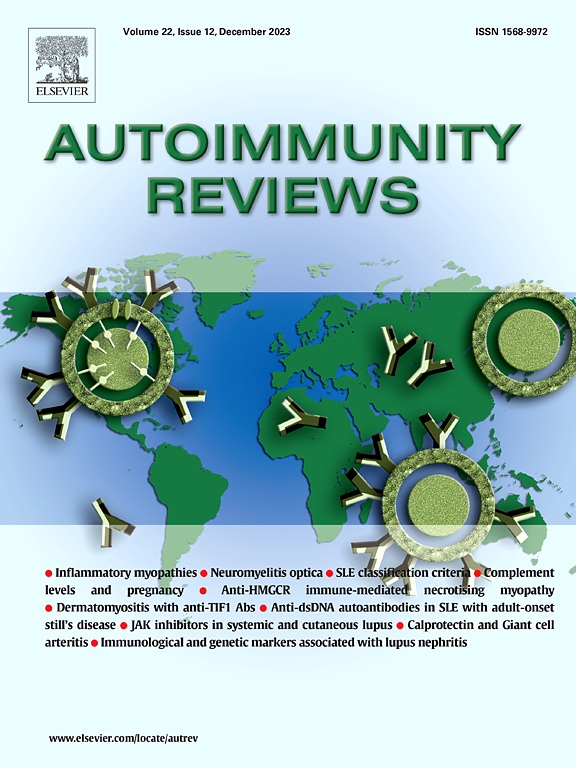白细胞介素-6在神经免疫疾病中的作用:病理生理学和satralizumab的治疗进展
IF 8.3
1区 医学
Q1 IMMUNOLOGY
引用次数: 0
摘要
白细胞介素-6 (IL-6)是一种由先天免疫系统和适应性免疫系统的多种细胞产生的多功能细胞因子。它在多个器官和系统的免疫、炎症、代谢和细胞功能中起调节作用。IL-6的功能是通过多种信号转导途径实现的,如JAK/STAT和NF-κB信号通路。在这篇综述中,我们重点介绍了IL-6的炎症和非炎症功能,以及相关的信号通路。IL-6在神经免疫疾病中的参与表明,白细胞介素-6受体(IL-6R)单克隆抗体satralizumab是一种潜在的治疗策略。III期临床试验已经验证了satralizumab治疗视神经脊髓炎谱系障碍(NMOSD)和乙酰胆碱受体(AChR)血清阳性的全身性重症肌无力(gMG)的安全性和有效性。本综述旨在阐明IL-6的病理生理作用,并探讨satralizumab在神经免疫性疾病中的临床意义,为其潜在的治疗应用提供见解。本文章由计算机程序翻译,如有差异,请以英文原文为准。
Interleukin-6 in neuroimmunological disorders: Pathophysiology and therapeutic advances with satralizumab
Interleukin-6 (IL-6) is a multifunctional cytokine produced by various cells of the innate and adaptive immune systems. It acts as a regulatory factor in immunity, inflammation, metabolism, and cellular function in multiple organs and systems. The functionality of IL-6 is achieved through multiple signal transduction pathways, such as the JAK/STAT and the NF-κB signaling pathways. In this review, we highlighted the inflammatory and non-inflammatory functions of IL-6, as well as the associated signaling pathways. The involvement of IL-6 in neuroimmunological disorders suggests that the interleukin-6 receptor (IL-6R) monoclonal antibody, satralizumab, is a potential therapeutic strategy. Phase III clinical trials have already validated the safety and efficiency of satralizumab in treating neuromyelitis optica spectrum disorders (NMOSD) and acetylcholine receptor (AChR) seropositive generalized myasthenia gravis (gMG). This review aims to elucidate the pathophysiological role of IL-6, and explore the clinical implications of satralizumab in neuroimmunological diseases, providing insights into its potential therapeutic applications.
求助全文
通过发布文献求助,成功后即可免费获取论文全文。
去求助
来源期刊

Autoimmunity reviews
医学-免疫学
CiteScore
24.70
自引率
4.40%
发文量
164
审稿时长
21 days
期刊介绍:
Autoimmunity Reviews is a publication that features up-to-date, structured reviews on various topics in the field of autoimmunity. These reviews are written by renowned experts and include demonstrative illustrations and tables. Each article will have a clear "take-home" message for readers.
The selection of articles is primarily done by the Editors-in-Chief, based on recommendations from the international Editorial Board. The topics covered in the articles span all areas of autoimmunology, aiming to bridge the gap between basic and clinical sciences.
In terms of content, the contributions in basic sciences delve into the pathophysiology and mechanisms of autoimmune disorders, as well as genomics and proteomics. On the other hand, clinical contributions focus on diseases related to autoimmunity, novel therapies, and clinical associations.
Autoimmunity Reviews is internationally recognized, and its articles are indexed and abstracted in prestigious databases such as PubMed/Medline, Science Citation Index Expanded, Biosciences Information Services, and Chemical Abstracts.
 求助内容:
求助内容: 应助结果提醒方式:
应助结果提醒方式:


